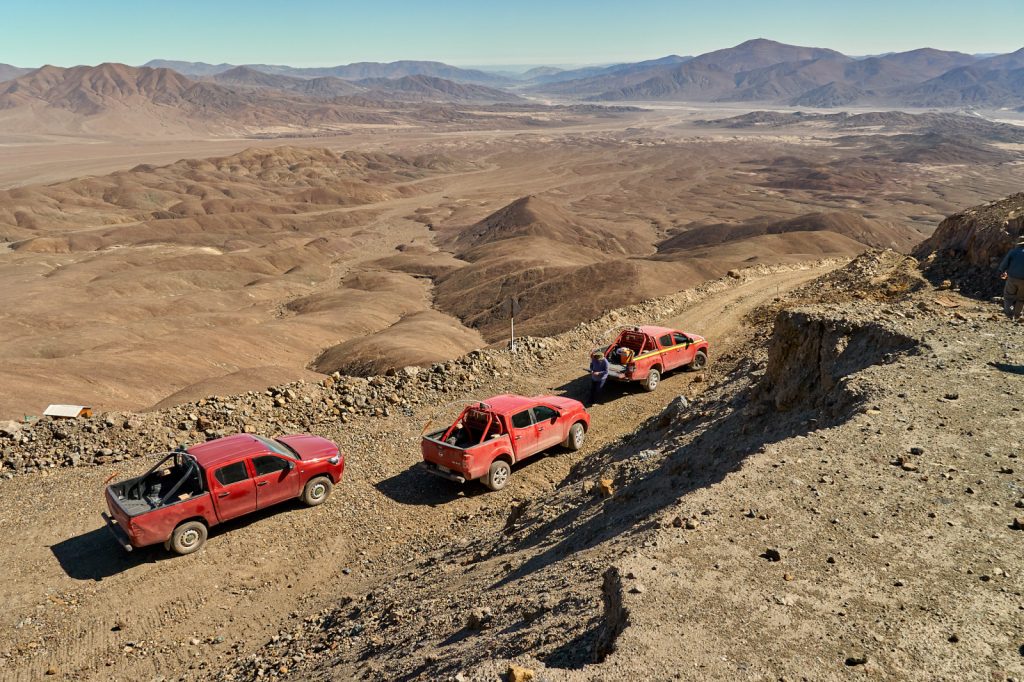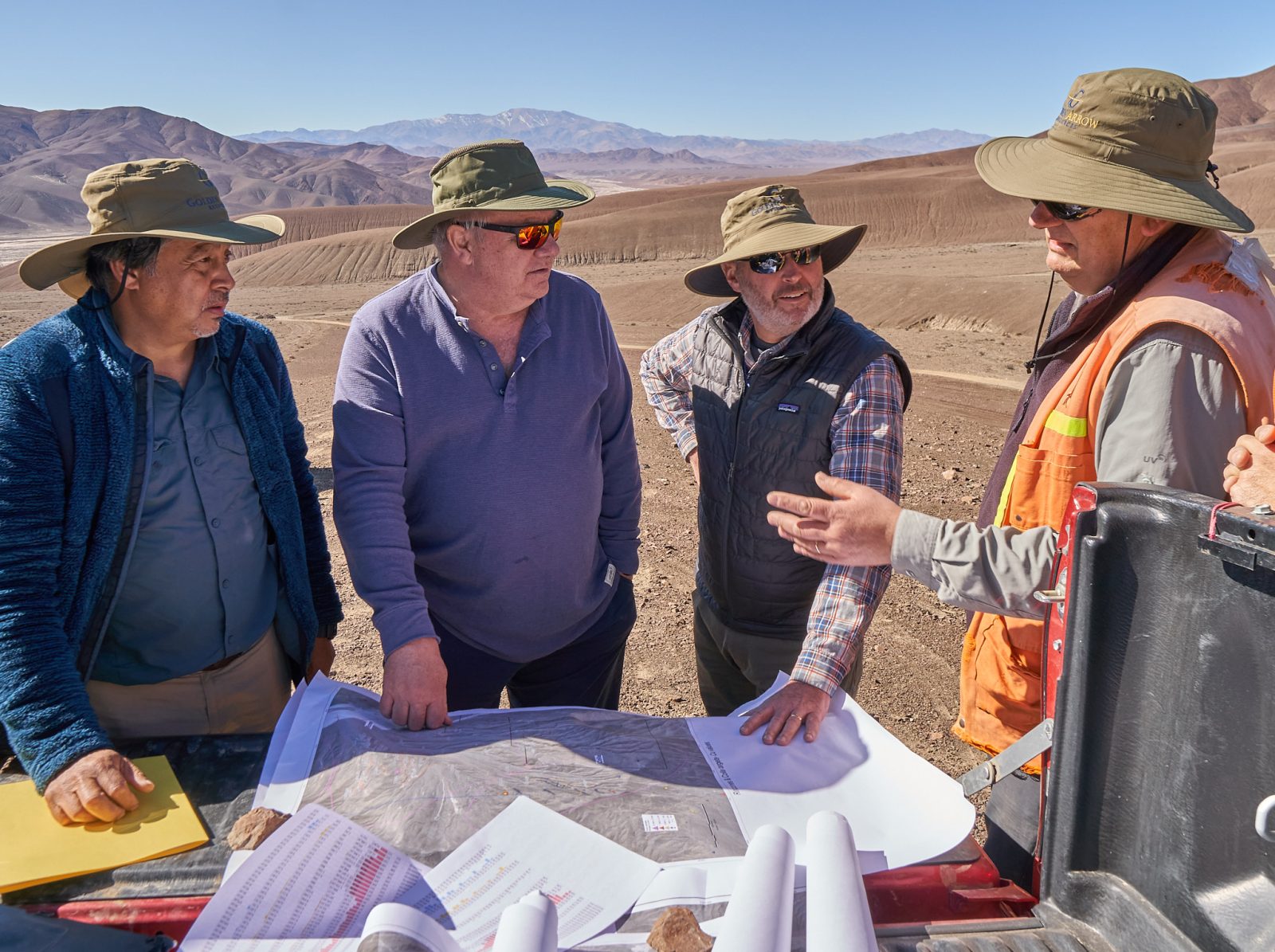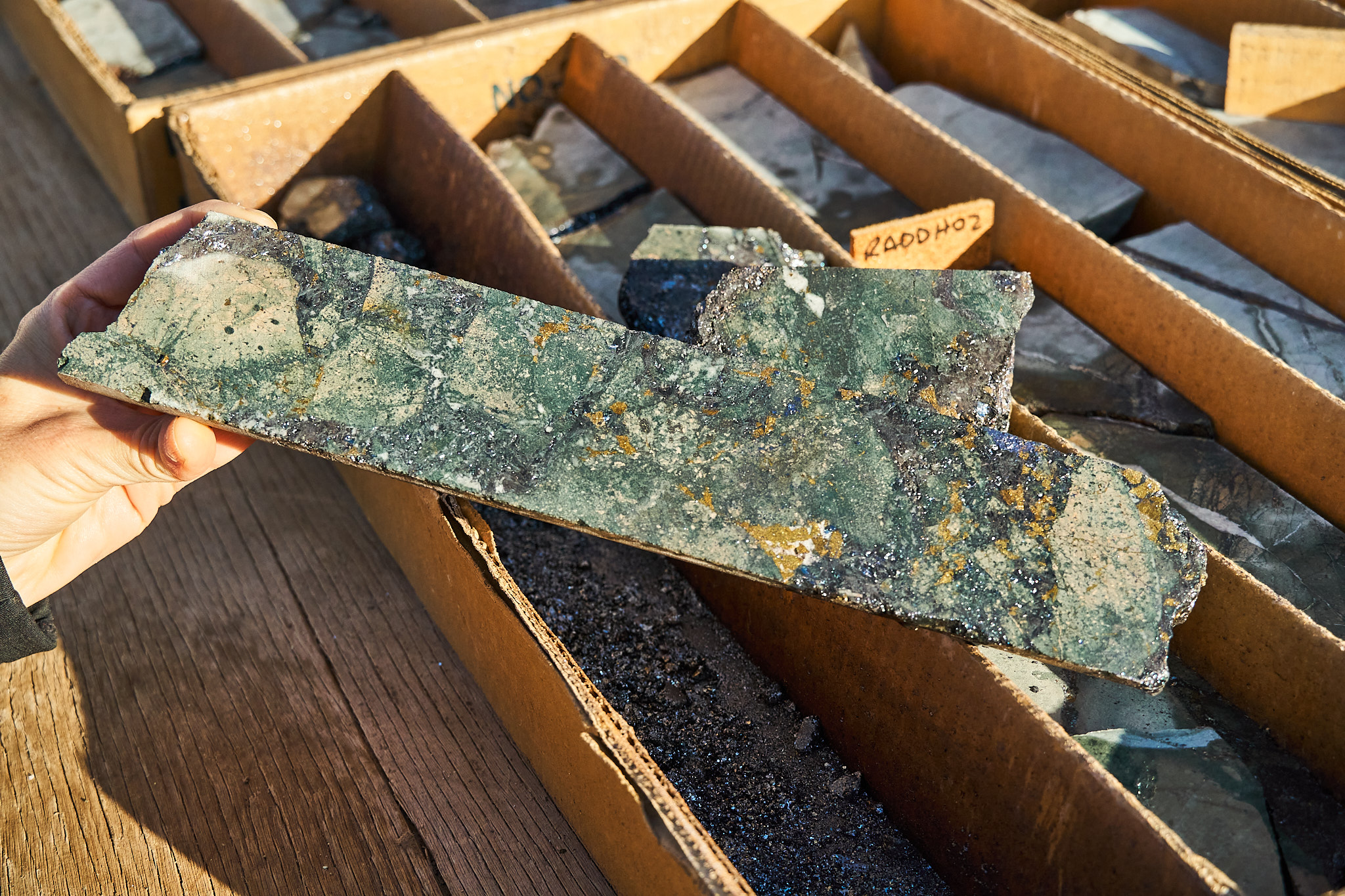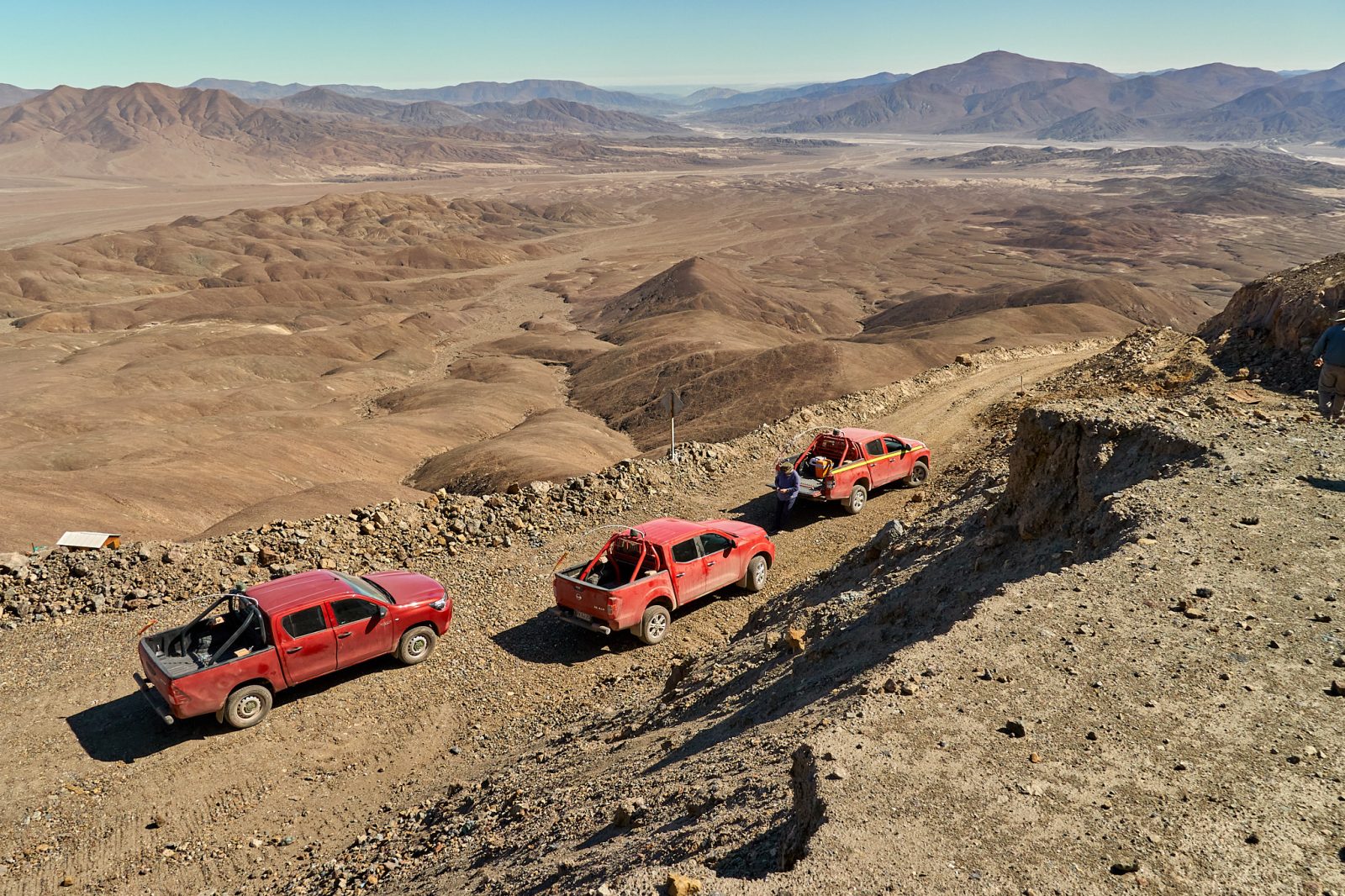San Pietro Site Visit: The right place, the right commodities, the right timing.

By Thomas Schuster, B.Sc., Geology
I recently had the opportunity to tour Golden Arrow Resources’ [GRG-TSXV; GARWF-OTCQB; G6A-FSE] new San Pietro project in the Atacama Desert of Chile. The project was previously drilled by Teck and Sumitomo more than a decade ago and hosts known Iron-Oxide-Copper-Gold (IOCG) and cobalt mineralization. This mineralization remains open for expansion and based on what I saw, it looks like there is excellent potential for additional discoveries on the 185 km2 property. This is worthy of any geologist’s and investor’s attention but what makes this project even more attractive is the fact that San Pietro is sandwiched between a large operating IOCG Mine and a development-stage IOCG project.
“What caught our attention with respect to the San Pietro project in Chile were the similarities with our Chinchillas project in Argentina,” commented Brian McEwen, VP of Exploration and Development for Golden Arrow Resources. “At Chinchillas we saw an opportunity to develop a project that was very close to SSR Mining’s Pirquitas Mine and here we have a project that sits between a mine that is about to be developed at Santo Domingo and an existing operating mine, Mantoverde, on the other side. So, we are right in the middle – the jelly in the donut if you will. This presents us an excellent opportunity.”
Golden Arrow Resources is no stranger to success. In September of 2019, the company sold its Chinchillas silver project to SSR Mining for CAD$44 million which included $3 million in cash and 1.245 million common shares of SSRM. The company is part of the successful pedigree of Grosso Group companies that have been involved in projects that have hosted four major discoveries over the last two decades.
On site visits like this one, I get the opportunity to not only view the geology first-hand and get a feel for the scale and potential of a project, but I also get to meet and talk with the local geological team. After doing so, I believe Golden Arrow has assembled an excellent group of people. Two of their senior project geologists were part of the exploration team that helped advance the nearby Santo Domingo project and have extensive experience with IOCG deposits. The company also includes members of the team that contributed to its success at Chinchillas. They were all eager to share their knowledge and exploration experience and were excited about exploring San Pietro.

Golden Arrow Senior Technical Team Reviews Rincones Target during Field Visit, August 2022. (L-R: Luis Parra, Senior Project Geologist; Brian McEwen, VP Exploration and Development; David Terry, Director; Hugo Caranza, Chief Geologist)
If you are interested in finding copper – Chile is still the place to be.
Chile hosts some of the biggest porphyry copper mines in the world including Escondida, Collahuasi, El Teniente and Chuquicamata to name just a few. According to a report “Mining in Chile – Statistics and Facts” written by Bruna Alves in 2021, Chile’s mining sector accounted for more than 12 percent of Chile’s GDP and generated 200 thousand direct jobs. Chilean mining exports added up to approximately 37 billion US dollars that year, or over half the national export value. Internationally, Chile’s production ranks amongst the highest in the world for a series of metals and minerals – including molybdenum, silver, and gold – but copper is undoubtedly the most important metal in the Chilean economy. Currently, Chile accounts for 28 percent of global copper production.
Most of the country’s copper production currently comes from massive porphyry-type deposits, however, IOCG-type deposits started to attract exploration attention following the discovery of the Candelaria deposit in 1986. Today, there are two large IOCG mining operations, the Candelaria complex with current estimated total mineral reserves of 675.6 Mt with average grades of 0.53% Cu and 0.13 g/t Au (Lundin Mining Mineral Reserves – June 30, 2021), and the Mantoverde deposit with 235.7 Mt averaging 0.6% Cu plus 0.11 g/t Au in sulphides and about 255.6 Mt averaging 0.24% Cu in oxides (Capstone Mining NI 43-101 P&P Reserve Nov 29 2021).
The main IOCG deposits in Chile are found in the Cretaceous Iron Belt (CIB) which lies along a 630 km-long portion of the Atacama Fault Zone (AFZ). This deep, crustal-scale, fault system more or less parallels the coast of Chile for over 1,200 km and hosts a diverse assemblage of metalliferous deposits.
San Pietro Project Location Map
IOCG deposits commonly contain the iron oxide minerals magnetite and/or hematite, as well as copper in chalcopyrite and sometimes bornite, plus gold. These deposits can also be enriched in elements such as cobalt, nickel, bismuth, selenium, or tellurium and/or rare earth elements and even uranium. The most significant IOCG deposits in Chile typically exhibit a combination of several mineralization styles which may include veins, breccias, stockworks, and mantos.
An Area of “Legendary” IOCG Discoveries
Mining has been an integral part of the Chilean identity since pre-colonial times. Over the course of the country’s history numerous colourful myths and legends have evolved. One legend is particularly interesting, given its modern-day correlation with the IOCG discovery near San Pietro.
The legend is about a giant mythical bird called the Alicanto that lives in the Atacama Desert. It is said that the Alicanto would eat metal ores and its wings would shine at night with beautiful metallic colors based on the different metals it had consumed. According to folklore, miners and prospectors would secretly follow an Alicanto hoping it would lead them to a rich deposit of metal ore.
After the discovery and development of the significant mineral resources at the Candelaria and Mantoverde deposits, exploration for IOGC deposits in Chile began in earnest. In 2002, Far West Resources and BHP Billiton formed an alliance to explore the Atacama Fault Zone around the Cretaceous Iron Belt. BHP Billiton developed a concept to explore the CIB for potentially overlooked hematite-dominated IOCG mineralization using the (then proprietary) Falcon geophysical survey method that utilized a fixed-wing aircraft. BHP’s Falcon gravity and magnetics survey consisted of a total of 14,539 line-km of airborne geophysics covering approximately a 300 km-long section of the CIB from TalTal to approximately 75 km south of Copiapó. The survey identified more than 76 target areas. One of these areas became the Santo Domingo deposit. Another one now hosts San Pietro.
So, in summary, a shiny winged flying creature with secret abilities helped lead modern-day geologists to discover IOCG deposits in the Atacama Desert. The Alicanto? Perhaps!
Ultimately a resource was outlined at Santo Domingo and in 2011 Capstone Mining swooped in to purchase the project through the acquisition of Far West Mining in a deal valued at over CAD$700million. In February of 2020, Capstone released an updated Preliminary Economic Assessment for Santo Domingo that included potential cobalt production. According to this PEA, Santo Domingo hosts Measured and Indicated resources of 537 Mt averaging 0.3% Cu, 0.039 g/t Au, 25.7% Fe and 229 g/t Co. The 2020 PEA process plan is based on production of a copper concentrate, a magnetite concentrate and battery-grade cobalt sulphate heptahydrate.
In 2022, Capstone Mining merged with Mantos Copper and became Capstone Copper. This combination added a 70% interest in the producing Mantoverde mine (as well as 100% interest in the Manto Blanco Mine) to Capstone’s portfolio.
Mantoverde is an open-pit mine that is comprised of four pits situated along the Mantoverde fault. The mine hosts both sulfide and oxide ores. Currently Capstone mines and processes only the oxide ore but the company is working on a US$784 million expansion project at Mantoverde that will incorporate sulphide ore reserves. It anticipates increasing production to 122 thousand tonnes of copper by 2024 and estimates the operation will have an All-In Sustaining Cost (AISC) of US$1.64 per payable pound of copper.
Capstone is also working on identifying and refining potential synergies between the Mantoverde and Santo Domingo Project. A detailed report is expected to be released in November of this year outlining these synergies and development plans for Santo Domingo.
The San Pietro Project – Strategic in Location and Time
Golden Arrow Resources acquired a 100% interest in the 185 km2 San Pietro property in early 2022 for just US$3.35 million. The project is strategically sandwiched between Capstone’s Santo Domingo property to the east and Capstone’s Mantoverde operating mine to the southwest. The heart of the San Pietro project is located just 35 kilometres northeast of the producing Mantoverde mine and nine kilometres west of the Santo Domingo resource.
Geologically there are many similarities between San Pietro and Santo Domingo. The alteration and mineralization styles on both properties are quite similar and they are both hosted in a sequence of volcanics and volcanoclastics of the Cretaceous-aged Punta del Cobre Formation. San Pietro has not been as extensively explored as Santo Domingo.
The town of Diego de Almagro, with a population of several thousand people, is located just 8 km by paved highway from San Pietro. Chañaral (population 10,000) is a deep-sea port less than one hour’s drive to the west of the property. The most important logistics centre in the region is Copiapó, about a two-hour drive south of the property. Copiapó has a population of approximately 150,000 people, an airport with daily scheduled flights to Santiago and Antofagasta and there are numerous companies there that offer services for mining and exploration.
“This is as good as it gets at an exploration project” stated Brian McEwen. “The San Pietro Property is huge; we are looking at 185 sq. km of exploration ground and we have already applied for additional concessions around and within this area. When we travel around the property, we see numerous targets we can go after. We are looking at cobalt, high-grade iron and of course copper and gold and I believe the opportunities for finding something exciting here are very, very good. The infrastructure here is exceptional. The property is on a major road 8 km from town and there is a power line right overhead.”
Drone View of San Pietro Project Looking SW; Rincones and Colla Target Areas. (View covers approximately 20km2 – the entire property holding is 185km2.)
San Pietro was originally explored by Teck Resources Limited and JOGMEC (Japan Oil, Gas and Metals National Corporation) and then later by Sumitomo Metal Mining Co., Ltd. The first campaigns were executed by Teck from 2006 to 2008, with a total of 20 reverse circulation drillholes completed. During the following five years, Sumitomo’s exploration continued with a diamond drill and included geological mapping, geophysics and rock sampling. Altogether, 83 drillholes, totaling 34,276 m were drilled on the property. Extensive hydrothermal alteration and mineralization was identified, and four main targets delineated: Rincones, Radiss Norte, Colla and Rodeo. Since 2013, no further drilling programs or exploration have been completed.
“When I’m asked why the previous companies left this project, we have to consider that San Pietro was first evaluated at a different time, over a decade ago. It was originally viewed as dominantly a copper project, but the commodity prices were significantly lower then,” commented Brian McEwen. “Now with the increased demand for copper and cobalt for the green economy, the price for these metals has increased significantly. We also must consider that back then the infrastructure was not like it is today. I think the timing is now perfect to re-evaluate San Pietro.”
Brian went on to say that Golden Arrow is just starting to scratch the surface at San Pietro. “One on hand it is an advanced project, and we want to advance it quickly, but it also has numerous exploration opportunities, and we want to understand how best to capitalize on those opportunities.”
The Radiss Norte, Rincones and Colla targets lie along the eastern side of the San Pietro property and trend in a northerly direction over a distance of about four km. The Rodeo target lies about three km northwest of Radiss Norte. Most of historical drilling performed on the property was focused along the eastern side of the property within a three km-wide corridor that encompasses the Radiss Norte and Rincones target areas. Putting that into perspective, that represents less than 7% of the entire 185 km2 property.
The drill results at Radiss Norte and Rincones targets are interpreted to represent a series of overlapping mineralized mantos that dip gently 15 to 20 degrees to the north.
Some highlights of historic drill results from the Rincones and Radiss Norte targets include:
- 1.14% Cu, 0.12g/t Au and 335ppm Co over 28 m starting at 236 m downhole in RA12DH-003 at Rincones;
- 1.20% Cu, 0.21g/t Au and 579ppm Co over 34 m starting at 370 m downhole in RADDH-02 at Rincones;
- 276 ppm Co over 58 m starting at 29 m downhole in RADDH-01 at Radiss Norte;
- 306 ppm Co over 29 m starting at surface in RADDH-05 at Radiss Norte.
Drill Core from RADDH-02 with Chalcopyrite in Specularite Breccia.
Looking at the historic core left behind by Sumotomo, Hugo Caranza, Chief Geologist for Golden Arrow Resources, pointed out that these mineralized mantos are hosted mainly in andesitic volcanics and are surrounded by an intense halo of potassic alteration. The property hosts several of these magnetite mantos that are in the order of 20-to-30 metres wide and contain disseminated specularite (a form of hematite) and chalcopyrite. Magnetite and specularite breccias and veins also host chalcopyrite and minor amounts of bornite, sometimes associated with pyrite. Cobalt is also present in some cases, and thin section work confirmed that it is encapsulated within the pyrite, which is also known to be the case at Santo Domingo.
While touring the property around the Rincones target area, I was able to climb into a few trenches that exposed mineralized and often brecciated structures that were several metres wide. It was relatively easily to follow the surface expression of these structures for many kilometers. These structures often outcropped and were pock-marked by a series of old artisanal workings. Hugo believes that these northwest-trending structures control, or are part of, the same feeder system that created the mantos at depth.
“Part of the future exploration plan will be to map and to sample all of the outcrops and old workings in the Rincones area,” commented Hugo. “Sumitomo only performed limited sampling and drilled mainly on geophysical anomalies. We need to complete detailed mapping to help understand the controlling structures of the mineralization and correlate that with what we see at depth in the historic drill holes.”
Only a few holes were drilled in the Rodeo and Colla targets and all the targets remain open for expansion with many prospective areas around these targets yet to be tested. The Rodeo target is interesting in that one historic hole intersected 34 metres averaging 1.03% Cu, 334ppm Co starting at 120 m downhole in hole RO12-005. This intercept appears to have intersected the same northwest-trending structure that is currently being mined by small-scale local miners on the northern side of the property. It is speculated that this same structure may continue to the Colla Target area located 5 km to the southeast.
Hugo pointed out one particularly interesting hole in the Colla area that has garnered much excitement among the geologists present.
“Hole number 2 in the Colla target is spectacular because we have an intercept grading 1000 ppm cobalt with low copper and iron,” stated Hugo. “The cobalt is associated with the pyrite and is hosted within a specularite breccia. This is part of a 30-metre-wide high cobalt interval that represents a high priority target that we will definitely follow-up on.”
The average of the entire 32-metre-long interval, CO-11-DH-002, was 0.01% copper, 414 g/t cobalt, 0.03 g/t gold and 16.1% iron, starting 116 metres down-hole. And while this hole was the highest in cobalt, it was not the only one to return high values over significant lengths of core at Colla. Hole CO11DH-001 intersected 626 g/t Co over 10 m starting at 211 m downhole.
There are still many under-explored areas such as the area south of Rodeo and north of Radiss Norte. There are also some interesting historical geophysical targets that need to be verified and tested. A large portion of the western side of the property is hidden under a layer of Atacama gravels that also represents a prime target area.
The next steps at San Pietro will be to relog a significant portion of the Sumitomo core in order to provide a better understanding of the mineralized structures and create a standardized core logging procedure for all geologists to use. In addition to that, an extensive geological mapping and sampling program will be undertaken over the project to better prioritize drill targets for the future drilling campaign.
View towards the Northwest Quadrant of the San Pietro Property.
Near the end of the site visit, I was standing on top of a high ridge that runs through the property. It afforded a tremendous view of the surrounding area, and I was able to get a better understanding of the immense scale of the project. The entire western side of the San Pietro project has seen very little exploration. I have to admit, I started looking to see if I could spot an Alicanto flying over this portion of the property. But alas, they only come out at night.
Golden Arrow Resources currently has a market capitalization of about $14 million with 144 million shares fully diluted. At last report it had $8.6 million in cash & equivalents.
About the Author
Thomas Schuster B.Sc., Geology
Thomas is a consultant, with over 25 years of experience in the resource sector. Having worked for Exploration Companies, Resource Industry Publications, as well as Marketing and Investment Firms, Thomas has developed a keen eye for undervalued companies and the ability to effectively communicate opportunity to the investing community via articles, reports, maps, photography and more recently site visit videos.




